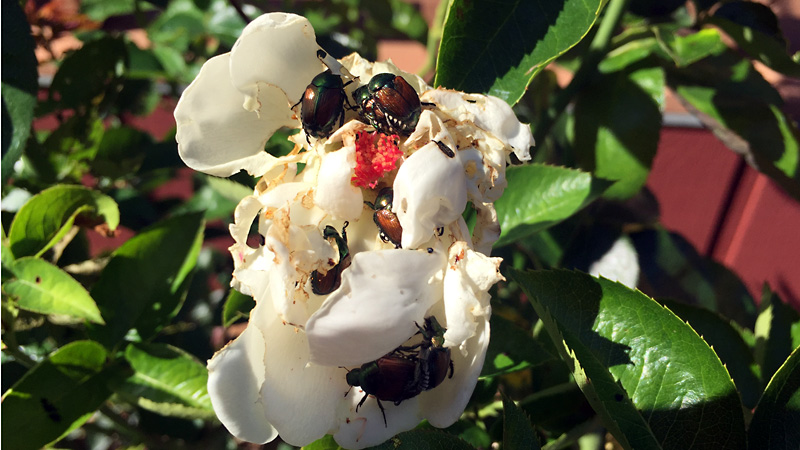Grubs plague lawn and garden in two stages of life
Grub control is all about timing. And forbearance — because the fight is ongoing. But worth the effort.
Anyone with a rose or vegetable garden in Southern Lower Michigan is sure to have done battle with Japanese beetles, And European chafer beetles, while not dining on your landscape, are also looking for a place to lay their eggs. All those eggs become grubs.
As destructive and creepy as these crunchy, non-native beetles are as adults, it’s nothing compared to the damage they do to lawns in their larval stage as white grubs.
Grubs are our Number 1 landscape pest. Greenlawn’s grub control is one of our most-requested services.
Timing is everything in grub control
Knowing more about the life cycle of grubs and the beetles they become will help you understand that you can’t just apply a big-box grub control product anytime you get around it.
You’d be wasting your money. Greenlawn, on the other hand, times our grub-control applications for maximum effectiveness.
By late June, adult beetles metamorphose from grub stage and start frolicking in lawns and gardens. Grub control doesn’t work then. Japanese beetles are too busy turning your rose blooms into yard waste.
European chafers are best spotted at dusk, swarming around trees. Both species take a moment to mate and lay eggs in the soil of your yard and garden beds.
By August, untold numbers of baby grubs are fattening up for winter on the tender roots of your turf. That’s when they’re closest to the surface and susceptible to grub control.
Oh, the damage grubs can do
If you have foregone grub control, too often, the presence of grubs only becomes known when brown patches develop or when raccoons or moles start wrecking the lawn as they feed on the grubs.
By that time, grubs are moving toward their winter home deeper into the soil, too deep to be affected by grub control.
Whether your lawn will experience a significant grub problem in any given year cannot be predicted. And your neighbor’s lawn may escape while yours is ravaged.
The amount of sun and moisture play a role. Researchers at Michigan State University and elsewhere have been actively studying and comparing methods of grub control.
Meanwhile, what can you do? Grub control products found in garden centers in the spring are ineffective if applied too early. By the time you notice the effect of grubs, it’s too late to do much of anything.
The smarter choice is to line up Greenlawn in advance or if you notice an abundance of the shiny green or brown beetles in your yard. The pros at Greenlawn pay attention to the life cycle of grubs and know exactly when to apply grub control.
What to do about a grub-ravaged yard
If grubs catch you by surprise and damage your turf, schedule some renovation work in early fall. First rake away dead grass, then water.
It’s possible that enough roots are left to send up new blades of grass. In thin or bare areas, reseeding may be required.

